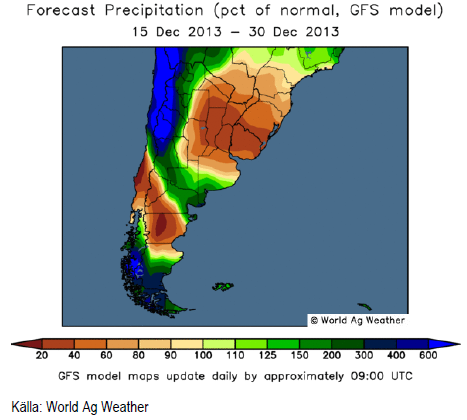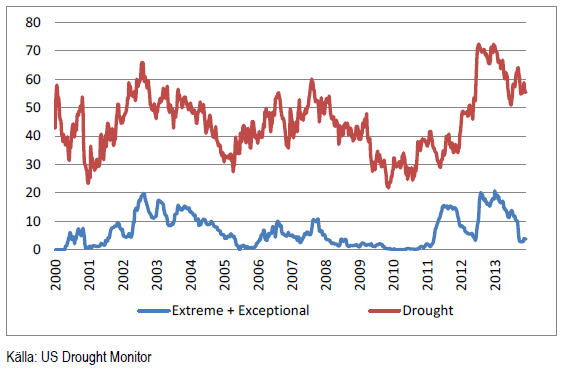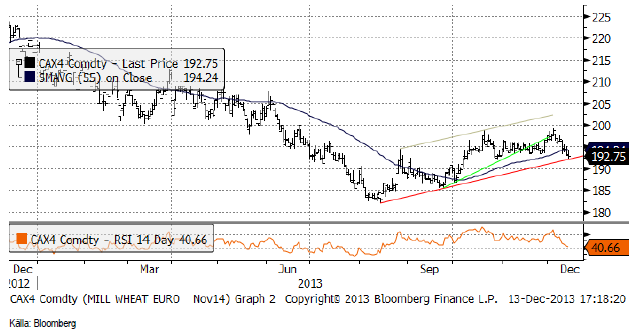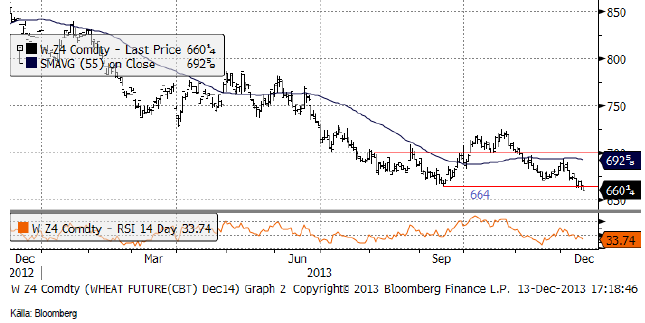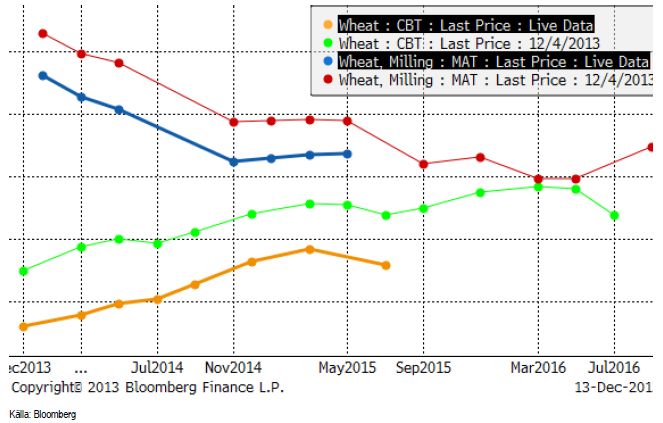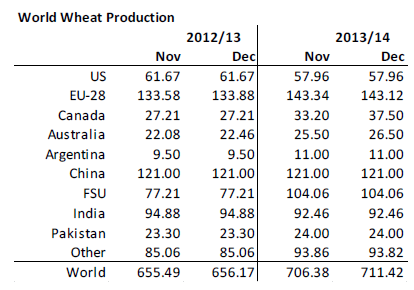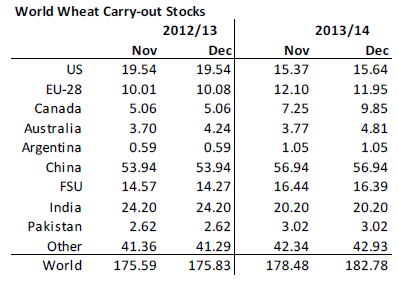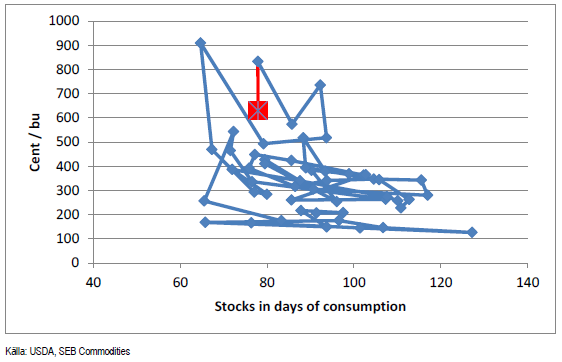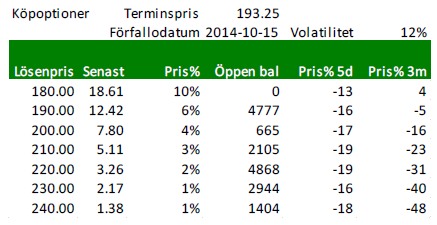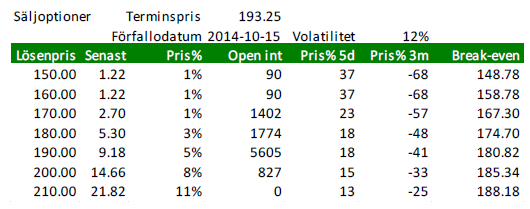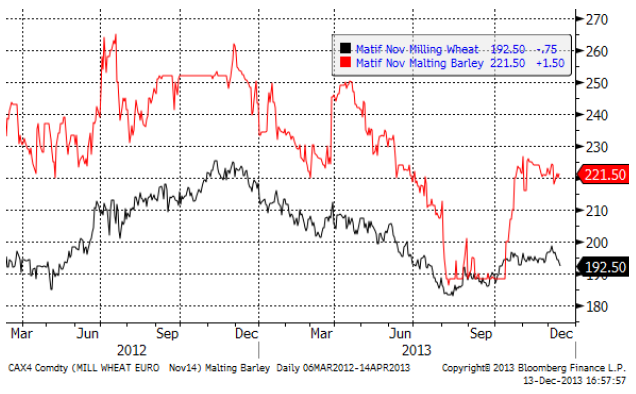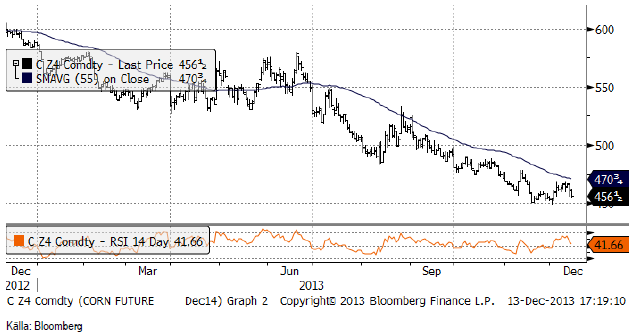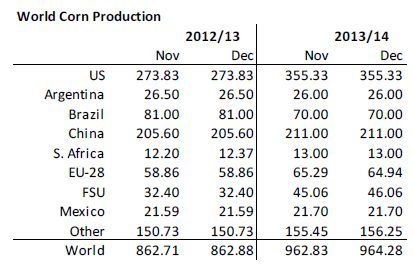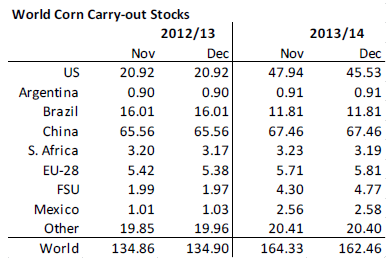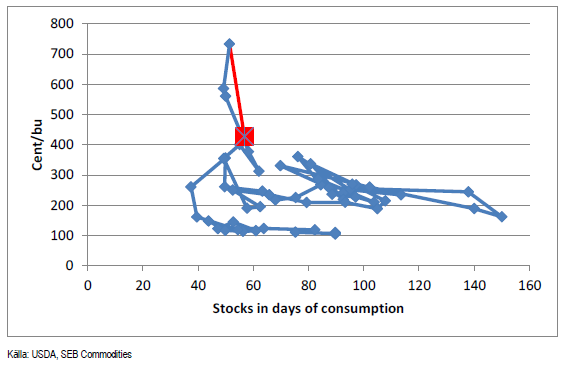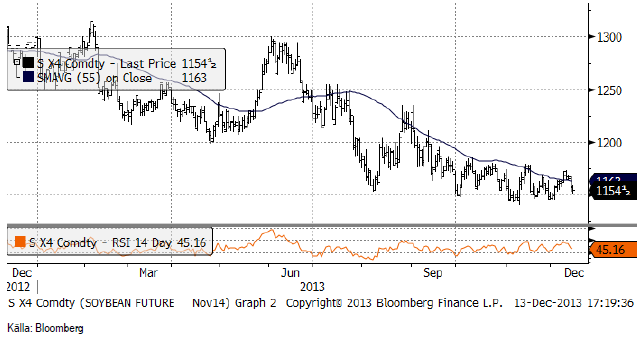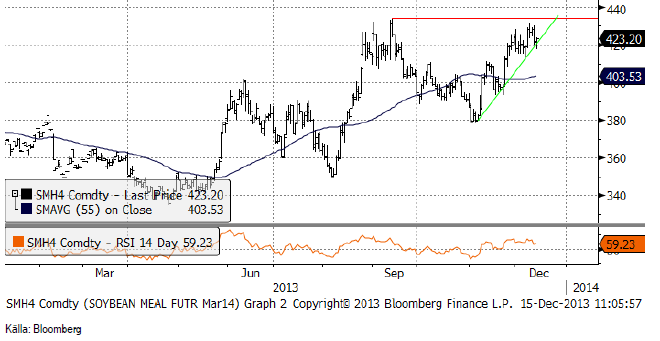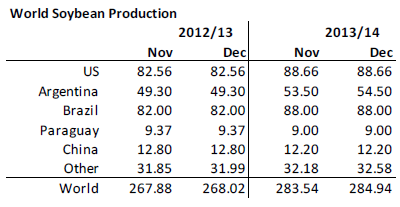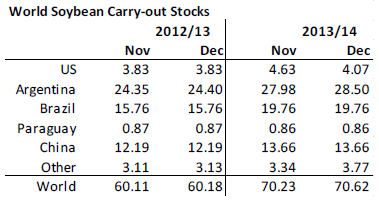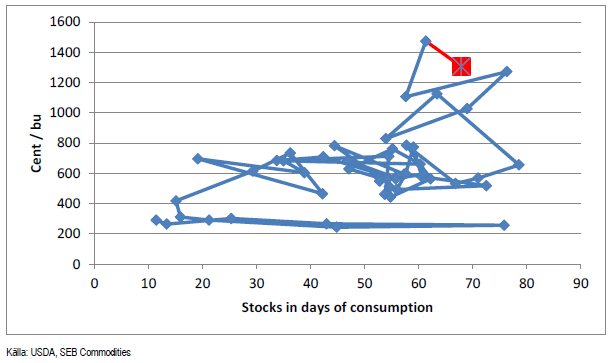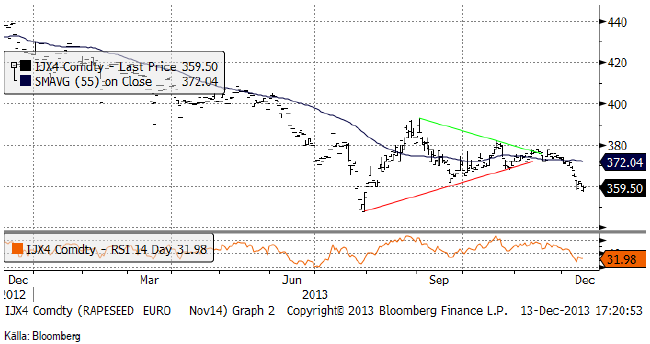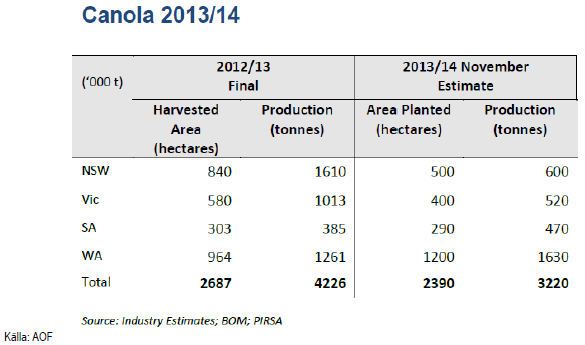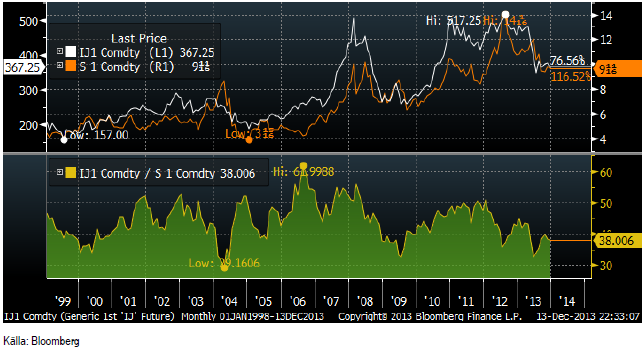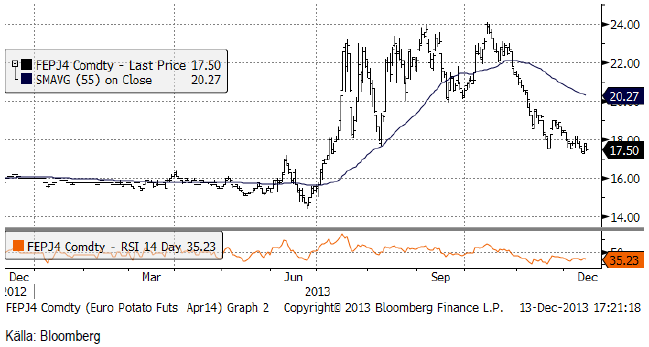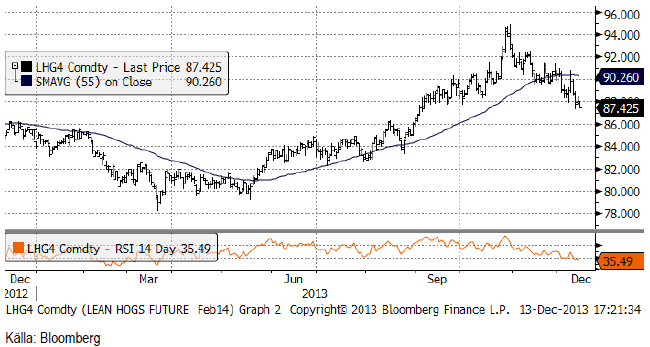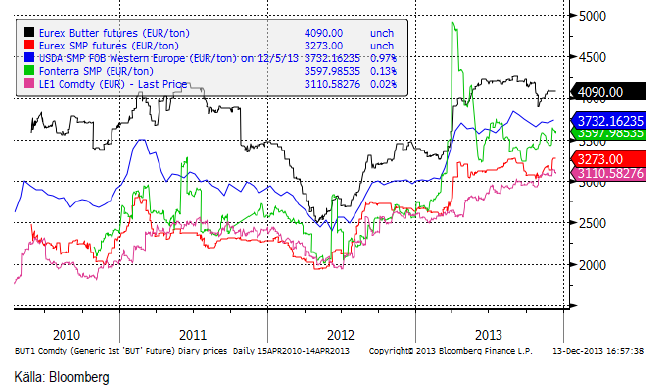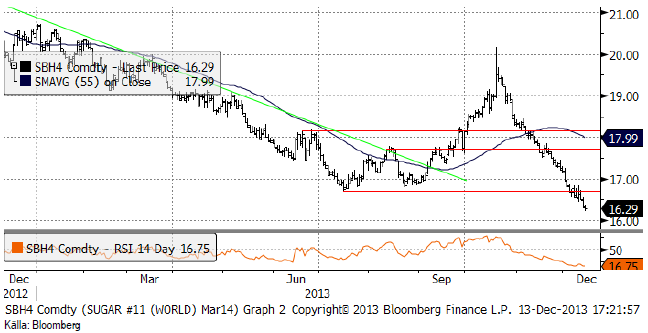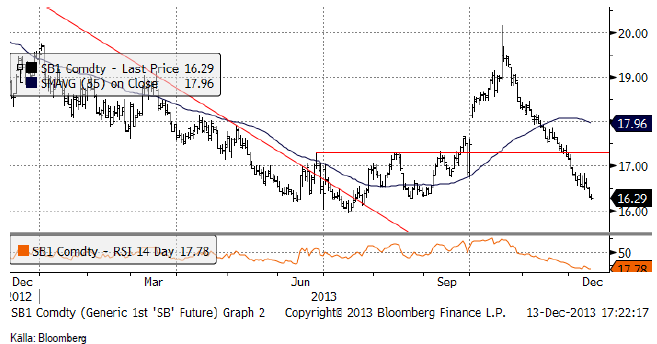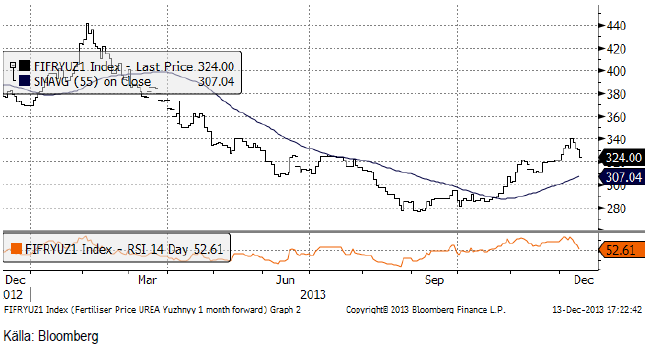Analys
SEB Jordbruksprodukter, 16 december 2013
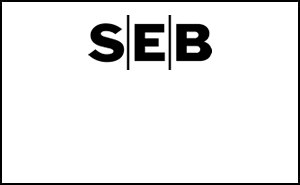

 Årets sista WASDE-rapport publicerades i tisdags och bekräftade Australiens och Kanadas rapporter, men nonchalerade Argentinas, alla från veckan innan. För sojabönor hamnade USDA på oförändrade 88 mt för Brasilien. Samma dag publicerade CONAB en prognos på 90 mt. Kanadas rapport för två veckor sedan fick canolan i Winnipeg i fritt fall, vilket börjar sprida sig till Europa nu. Att Frankrike höjde rapsarealen istället för att som väntat sänka den, kommer att bidra till att baissen får grepp i Europa också.
Årets sista WASDE-rapport publicerades i tisdags och bekräftade Australiens och Kanadas rapporter, men nonchalerade Argentinas, alla från veckan innan. För sojabönor hamnade USDA på oförändrade 88 mt för Brasilien. Samma dag publicerade CONAB en prognos på 90 mt. Kanadas rapport för två veckor sedan fick canolan i Winnipeg i fritt fall, vilket börjar sprida sig till Europa nu. Att Frankrike höjde rapsarealen istället för att som väntat sänka den, kommer att bidra till att baissen får grepp i Europa också.
Jag tror att vetemarknaden kommer att ha en lite svagare utveckling framöver och går därför över till en kortsiktig säljrekommendation (från neutral).
Mjölkpriserna basis Eurex SMP och smör-terminer steg med 1% i svenska kronor per kilo mjölkråvara och det berodde helt på att kronan försvagades mot euron. Mjölkbörserna var annars lite svagare i veckan än förut.
Nästa WASDE-rapport publiceras den 10 januari och det här veckobrevet är också det sista för året och önskar alla läsare en God Jul och ett Gott Nytt År 2013.
Odlingsväder
Det är både blötare och varmare i Europa än normalt och detta väntas bestå åtminstone fram till slutet av året. I Nordamerika drar i skrivande stund en snöstorm fram, som fått flygen att bli inställda t ex i Toronto.
I Sydamerika, kan vi notera att det är onormalt varmt och lite nederbörd i norra Argentina, landets kornbod. Vi ser detta i kartbilden nedan.
I Brasiilien är vädret alltjämt normalt.
En hastig blick på US Drought Monitor, visar att det inte varit några stora förändringar i hur stor andel av USA:s areal som är torrare än normalt.
Vete
Terminskontrakten i Chicago föll med 3% i veckan och Matif med 2%. WASDE-rapporten i sig själv påverkade inte marknaden, eftersom den inte innehöll något nytt, utan snarare bekräftade produktionshöjningarna i Kanada och Australien från veckan innan och som väntat nonchalerade Argentinas påstående att skörden skulle bli 8.5 mt istället för 11 mt som alla andra utom den Argentinska staten förväntat sig.
Tekniskt stängde Matif precis på stödet för uppgången från början av augusti. Eftersom Chicagovetet i fredags gick under stödet på 664 cent (basis Dec 2014-kontraktet), skulle det inte förvåna om Matif bröt stödet och inledde en rekyl nedåt. November 2014-kontraktet låg i fredags på 192.75 och om stödet bryts finns nästa stöd på 185 euro. Vi skulle tro att priset går dit. Eventuellt finns stöd på 190, där priset kan studsa som hastigast.
Decemberkontraktet 2014 på CBOT som föll tillbaka ner mot det tekniska stödet, efter ABARES och Stats Canadas rapporter, bröt igenom stödet på 664 i fredags. Det är en teknisk säljsignal.
Nedan ser vi terminskurvorna för Chicagovete och Matif.
I tisdags kom så årets sista WASDE-rapport från USDA. USDA fick med och tog till sig de nya högre produktionsestimaten från veckan innan från Kanada (37.5 mt) och Australien (26.5), men gjorde inte det för Argentina, där USDA fortfarande har 11 mt. Det står ju helt klart att Argentinas produktionsestimat är lågt därför att det då begränsar exporten till 1.5 mt och inte 4 mt som det hade varit om de hade sagt 11 mt. Sammantaget justeras alltså global produktion 2013/14 upp med 5 mt till 711.42 mt.
Höjningen av produktionsestimatet så plötsligt gör också att utgående lager justeras upp. Det finns ju ingen anledning att tro att konsumtionen ska öka om inte priset sjunker, eller tillväxten i tillväxtländer tar fart. Utgående lager justeras upp med 4 mt. Det kan synas märkligt att man inte höjde med 5 mt, eftersom inget har hänt som motiverar högre konsumtion.
Ser vi till prisets relation till utgående lager, ligger priset möjligtvis något lågt om vi jämför med den allmänna bilden som förhållandet mellan pris och lager de senaste åren ger. Å andra sidan kan vi jämföra med punkten för fem år sedan, när priset var 100 cent lägre för nästan samma nivå på lagret. Det är alltså svårt att dra några entydiga slutsatser om priset just nu är för ”högt” eller för ”lågt”.
Vi tror det kommer en period med lite svagare marknad nu, med en mindre nedgång i terminerna på vete. På ett lite längre perspektiv är vi mer eller mindre neutrala, men på kort sikt går vi över från neutral till säljrekommendation.
Optioner på vete
Nedan ser vi priserna på köpoptioner på Matif på November-2014 (Matif vete). Notera att historisk volatilitet har stigit upp från 11% till 12% igen.
Nedanstående är priser på säljoptioner.
Maltkorn
November 2014 – kontraktet på har den senaste tiden gått lite svagare än Matif-vetet.
Majs
Majspriset reagerade på WASDE-rapporten, till skillnad från vetet. Trots att utgående lager justerades ner, oroar sig marknaden för att januari-rapporten ska visa högre produktion både i USA och i Kina. Kinas eget estimat, som kom härom veckan, ligger 6.5 mt högre än USDA. Tekniskt ser marknaden illavarslande ut, då priset ser ut att återigen vara på väg ner till den psykologiskt viktiga nivån 450 cent. Ska det bli tredje gången gillt och ett fall under den nivån?
USDA justerade upp global produktion med 1.5 mt. En liten sänkning gjordes av estimatet för EU-28, skörden i fd Sovjet (Ukraina) höjdes ytterligare, med 1 mt. Men det saknas alltså +6.5 mt på Kina. Att Kina inte verkar importera majs från USA i samma utsträckning som tidigare, indikerar att Kina verkligen har fått en bättre skörd än väntat. Marknaden ser det så i alla fall, och ”justerar” USDA:s estimat så att den global produktion nu är 8 mt högre än estimerat i november.
USDA sänker utgående lager med 2 mt, därför att man räknar med högre foderefterfrågan i EU-28, Kanada, Ukraina och högre efterfrågan på majs till etanoltillverkning i USA. Detta verkar rimligt med tanke på boomen i kött och mjölkpriser. Det är nog en trend vi kommer att se mer höjningar i konsumtionen för. Men vi tror inte att höjningen av efterfrågan på majs till etanolindustrin är långsiktigt hållbar. Kina har dessutom satt en båtlast med DDG (drank) från USA i karantän därför att man misstänker att den innehåller GMO-vara av en sort som är förbjuden i Kina. Skulle DDG-exporten till Kina stanna av, skulle ekonomin i etanoltillverkningen försämras, allt annat lika.
”Egentligen” skulle den här rapporten, med Kinas egna produktionsestimat, ha visat högre utgående lager.
Priset ser ut att ligga ”OK” i förhållande till estimerat utgående lager och i förhållande till de senaste årens relation mellan pris och lager.
Vi fortsätter med neutral rekommendation, men skulle 450 cent brytas, bör man vara nettosåld majs, pga vad den tekniska analysen då säger.
Sojabönor
Även sojabönorna föll efter WASDE-rapporten. 1150 cent är dock ett starkt stöd för marknaden. 55% av Brasiliens sojaskörd är enligt uppgifter därifrån redan såld / prissäkrad.
Gammal skörd av sojamjöl (mars-kontraktet 2014) lyckades inte ta sig upp till en ny all-time-high i veckan. Priset ligger precis på stödlinjen för uppgången. Det skulle inte förvåna om säljare kommer in här, samtidigt som köpare tar hem vinster och vi får ett brott av stödlijen, med prisfall ner till 400 dollar som följd.
WASDE-rapporten visade 1.5 mt högre produktion. Argentina höjdes 1 mt och övriga länder med 0.5. Värt att notera är att produktionen antagligen är högre än vad USDA har estimerat här i december-rapporten. Dels är estimatet för Argentina på 54.5 mt fortfarande 3 mt lägre än vad USDA:s egen attaché vid FAS rapporterade härom veckan. Dels är estimatet för Brasilien oförändrat på 88 mt, när CONAB och många privata firmor på plats ligger på 90 mt. Kanske avvaktar USDA hur vädret utvecklar sig i Argentina och Brasilien. I Argentina har det blivit lite varmare, men i Brasilien är vädret muito bom.
Med en produktionsökning på 1.5 mt höjer USDA utgående lager med 0.5 mt – allt i Argentina – vilket förmodligen är helt riktigt. Utgående lager sänktes för USA, vilket också verkar rimligt med tanke på prisutvecklingen för griskött och mjölk, t ex. Efterfrågan på sojamjöl kommer antagligen att fortsatt vara stark.
För fyra år sedan var lagernivån på ungefär samma nivå som nu och priset var 150 cent lägre. Det talar för en svag prisutveckling framöver. Det är dock värt att hålla koll på vart priserna på mjölk och lean hogs tar vägen framöver. Skulle de fortsätta att stärkas och därmed stimulera till större besättningar, kan efterfrågan på sojamjöl vara en faktor som dämpar eller hindrar prisfall på sojan.
Kina har satt en båtlast med DDG i karantän för undersökning av GMO-innehåll. Risken är att DDG som gått till Kina kommer att stanna i USA – och därmed pressa priset på sojamjöl.
Vi behåller säljrekommendation.
Raps
November 2014-kontraktet som jag säljrekommenderade förra veckan föll ner till 360 euro. Priset bröt även den nivån mot slutet av veckan och nästa nivå i sikte är nu 350 euro. Vi fortsätter med säljrekommendation.
Frankrike höjde rapsarealen med 7% jämfört med förra året. Den allmänna uppfattningen under hösten var att den skulle bli mindre, pga den försämrade lönsamheten i valet av raps framför t ex vete.
AOF (Australian Oilseeds Federation) gör endast en mindre nedjustering från tidigare estimat för landets produktion av canola 2013/14, detta trots en betydande negativ påverkan på grödorna till följd av frost i New South Wales och Victoria. Produktionen beräknas uppgå till 3.2 mt i år, ner från tidigare estimat på 3.4 mt och förra årets produktion på 4.2 mt. En varm start på våren påskyndade grödornas utveckling och gjorde dem mer känsliga för extrema väderslag, vilket gjorde att torra väderförhållanden och frost under våren fick en betydande inverkan på grödorna i NSW och Victoria. Bortfallet av grödor i östkust staterna har dock nästan helt kompenserats av avkastningen i Western Australia där de säsongsmässiga förhållandena har varit näst intill perfekta under de senaste månaderna.
Produktionen av raps i EU-28 förväntas uppgå till 21.3 mt 2014/15 enligt Strategie Grains, en ökning med 500 000 ton eller 2.4% från årets 20.8 mt då högre avkastning förväntas kompensera en liten nedgång i sådd. Den genomsnittliga avkastningen för nästa års skörd beräknas uppgå till 3.2 t/ha mot årets 3.1 t/ha, vilket skulle kompensera för en minskad areal (från 6.7 mha till 6.6 mha).
Efter nyheten om rekordskörden av canola i Kanada, har rapspriset förlorat mark i förhållande till soja. I diagrammet nedan ser vi att detta är en fortsättning på en trend, som inleddes redan 2006, när raps var som dyrast i förhållande till soja. I diagrammet nedan har jag räknat om sojapriset till euro (per bushel).
Canolaterminerna i Kanada har förlorat ännu mer mark i förhållande till sojabönorna i Chicago i veckan som gått. Rapspriset på Matif har inte riktigt tagit in det prisfallet.
Vi fortsätter med förra veckans säljrekommendation.
Potatis
Potatispriset av årets skörd, har fortsatt att handlas svagt och noterades i fredags en halv euro lägre per deciton, på 17.50 euro.
Gris
Lean hogs mars-kontrakt fortsatte att gå ner i pris i veckan som gick och stängde 1.5 cent lägre än förra veckan. Lägre pris på lean hogs är en faktor som påverkar soja- och majspriserna negativt.
Mjölk
SMP-terminerna på Eurex var oförändrade i veckan. SMP handlades lite starkare i början på veckan, men var sedan oförändrade. Smörpriset var oförändrat. I svenska kronor steg priset med 1% för alla terminsköptider, eftersom euron steg mot kronor.
Terminspriserna i Chicago sjönk faktiskt. Prisuppgången som varit mycket stadig i ett och ett halvt år, tycks hålla på att tappa lite av sitt momentum och det märks tydligast i prisutvecklingen på smör.
I diagrammet nedan har jag lagt till priset på CME:s SMP-kontrakt, omräknat till euro per ton och därmed i samma enhet som de andra prisserierna. Det är den lila kurvan. Vi ser att den faktiskt och inte så förvånande, följer Eurex SMP-termin.
Nedan ser vi terminspriserna man får i svenska kronor från terminspriserna på SMP och smör på Eurex, omräknat till kronor per kilo mjölkråvara. Notera dock att hela den här prisnivån alltid ska ligga över avräkningspriset på mjölkråvara med ca 50 öre, som är en uppskattning av kostnaden för att förädla mjölkråvara till SMP och smör.
Socker
Marskontraktet på råsocker har till vår stora besvikelse fortsatt att falla till kontraktslägsta på 16.29 cent per pund i marskontraktet. RSI ligger på en ny lägsta nivå om 16.75. En nivå under 30 brukar anses indikera en ”översåld” marknad och en nära förestående rekyl. En så här lång period av rekylfri nedgång är mycket ovanlig och kan bara förklaras av att många måste ha trott på en rekyl uppåt tidigare, liksom vi, och successivt tagit stoppar. Det är svårt att resonera här, för trots att priset faller, så byggs potentialen i rekylen uppåt upp allt mer, ju mer priset faller. Å andra sidan föll priset under det tekniska stödet på 16.60, vilket indikerar ytterligare svaghet i marknaden.
Om vi ser till ”spotkontraktet”, ser vi att prisfallet börjar nå ner till 16 cent, som var bottennoteringen i juli. Det är en nivå där det bör finnas stöd.
Marknaden har fortsatt handla starkt vid starten på handelsdagen, dvs under europeisk dagtid, för att sedan falla under amerikansk handelstid. Skörden i Brasilien har förbättrats mot slutet och det är antagligen producenter som prissäkrar, särskilt då priset i reais inte fallit som det gjort i dollar. Den Thailändska skörden börjar nu och det kan också vara en orsak till den påtagliga svagheten i prisutvecklingen just nu. Importmarginalen till Kina är negativ. Kina är en av världens största importörer.
Vi tror att botten noterades i juli och att den i och för sig mycket kraftiga nedgången är en rekyl.
Produktionsöverskottet går mot sitt slut och därmed finns en potential för priset att nå upp till produktionskostnaden. Vi rekommenderar köp av SOCKER S eller BULL SOCKER X4 S för den som vill ta mer risk.
Gödsel
Förra veckan skrev vi att marknaden för urea var överköpt med ett RSI på 80 (över 70, som är gränsen för en ”överköpt” marknad. Priset har nu fallit tillbaka från 340 dollar till 324 dollar. Trenden är dock uppåtriktad, alltjämt och vi ser detta som ett köptillfälle.
[box]SEB Veckobrev Jordbruksprodukter är producerat av SEB Commodities Sales desk och publiceras i samarbete och med tillstånd på Råvarumarknaden.se[/box]
Detta marknadsföringsmaterial, framtaget av SEB’s Commodities Sales desk, har upprättats enbart i informationssyfte.
Även om innehållet är baserat på källor som SEB bedömt som tillförlitliga ansvarar SEB inte för fel eller brister i informationen. Den utgör inte oberoende, objektiv investeringsanalys och skyddas därför inte av de bestämmelser som SEB har infört för att förebygga potentiella intressekonflikter. Yttranden från SEB’s Commodities Sales desk kan vara oförenliga med tidigare publicerat material från SEB, då den senare hänvisas uppmanas du att läsa den fullständiga rapporten innan någon åtgärd vidtas.
Dokumentationen utgör inte någon investeringsrådgivning och tillhandahålls till dig utan hänsyn till dina investeringsmål. Du uppmanas att självständigt bedöma och komplettera uppgifterna i denna dokumentation och att basera dina investeringsbeslut på material som bedöms erforderligt. Alla framåtblickande uttalanden, åsikter och förväntningar är föremål för risker, osäkerheter och andra faktorer och kan orsaka att det faktiska resultatet avviker väsentligt från det förväntade. Historisk avkastning är ingen garanti för framtida resultat. Detta dokument utgör inte ett erbjudande att teckna några värdepapper eller andra finansiella instrument. SEB svarar inte för förlust eller skada – direkt eller indirekt, eller av vad slag det vara må – som kan uppkomma till följd av användandet av detta material eller dess innehåll.
Observera att det kan förekomma att SEB, dess ledamöter, dess anställda eller dess moder- och/eller dotterbolag vid olika tillfällen innehar, har innehaft eller kommer att inneha aktier, positioner, rådgivningsuppdrag i samband med corporate finance-transaktioner, investment- eller merchantbankinguppdrag och/eller lån i de bolag/finansiella instrument som nämns i materialet.
Materialet är avsett för mottagaren, all spridning, distribuering mångfaldigande eller annan användning av detta meddelande får inte ske utan SEB:s medgivande. Oaktat detta får SEB tillåta omfördelning av materialet till utvald tredje part i enlighet med gällande avtal. Materialet får inte spridas till fysiska eller juridiska personer som är medborgare eller har hemvist i ett land där sådan spridning är otillåten enligt tillämplig lag eller annan bestämmelse.
Skandinaviska Enskilda Banken AB (publ) är ett [publikt] aktiebolag och står under tillsyn av Finansinspektionen samt de lokala finansiella tillsynsmyndigheter i varje jurisdiktionen där SEB har filial eller dotterbolag.
Analys
Tightening fundamentals – bullish inventories from DOE

The latest weekly report from the US DOE showed a substantial drawdown across key petroleum categories, adding more upside potential to the fundamental picture.

Commercial crude inventories (excl. SPR) fell by 5.8 million barrels, bringing total inventories down to 415.1 million barrels. Now sitting 11% below the five-year seasonal norm and placed in the lowest 2015-2022 range (see picture below).
Product inventories also tightened further last week. Gasoline inventories declined by 2.1 million barrels, with reductions seen in both finished gasoline and blending components. Current gasoline levels are about 3% below the five-year average for this time of year.
Among products, the most notable move came in diesel, where inventories dropped by almost 4.1 million barrels, deepening the deficit to around 20% below seasonal norms – continuing to underscore the persistent supply tightness in diesel markets.
The only area of inventory growth was in propane/propylene, which posted a significant 5.1-million-barrel build and now stands 9% above the five-year average.
Total commercial petroleum inventories (crude plus refined products) declined by 4.2 million barrels on the week, reinforcing the overall tightening of US crude and products.


Analys
Bombs to ”ceasefire” in hours – Brent below $70

A classic case of “buy the rumor, sell the news” played out in oil markets, as Brent crude has dropped sharply – down nearly USD 10 per barrel since yesterday evening – following Iran’s retaliatory strike on a U.S. air base in Qatar. The immediate reaction was: “That was it?” The strike followed a carefully calibrated, non-escalatory playbook, avoiding direct threats to energy infrastructure or disruption of shipping through the Strait of Hormuz – thus calming worst-case fears.

After Monday morning’s sharp spike to USD 81.4 per barrel, triggered by the U.S. bombing of Iranian nuclear facilities, oil prices drifted sideways in anticipation of a potential Iranian response. That response came with advance warning and caused limited physical damage. Early this morning, both the U.S. President and Iranian state media announced a ceasefire, effectively placing a lid on the immediate conflict risk – at least for now.
As a result, Brent crude has now fallen by a total of USD 12 from Monday’s peak, currently trading around USD 69 per barrel.
Looking beyond geopolitics, the market will now shift its focus to the upcoming OPEC+ meeting in early July. Saudi Arabia’s decision to increase output earlier this year – despite falling prices – has drawn renewed attention considering recent developments. Some suggest this was a response to U.S. pressure to offset potential Iranian supply losses.
However, consensus is that the move was driven more by internal OPEC+ dynamics. After years of curbing production to support prices, Riyadh had grown frustrated with quota-busting by several members (notably Kazakhstan). With Saudi Arabia cutting up to 2 million barrels per day – roughly 2% of global supply – returns were diminishing, and the risk of losing market share was rising. The production increase is widely seen as an effort to reassert leadership and restore discipline within the group.
That said, the FT recently stated that, the Saudis remain wary of past missteps. In 2018, Riyadh ramped up output at Trump’s request ahead of Iran sanctions, only to see prices collapse when the U.S. granted broad waivers – triggering oversupply. Officials have reportedly made it clear they don’t intend to repeat that mistake.
The recent visit by President Trump to Saudi Arabia, which included agreements on AI, defense, and nuclear cooperation, suggests a broader strategic alignment. This has fueled speculation about a quiet “pump-for-politics” deal behind recent production moves.
Looking ahead, oil prices have now retraced the entire rally sparked by the June 13 Israel–Iran escalation. This retreat provides more political and policy space for both the U.S. and Saudi Arabia. Specifically, it makes it easier for Riyadh to scale back its three recent production hikes of 411,000 barrels each, potentially returning to more moderate increases of 137,000 barrels for August and September.
In short: with no major loss of Iranian supply to the market, OPEC+ – led by Saudi Arabia – no longer needs to compensate for a disruption that hasn’t materialized, especially not to please the U.S. at the cost of its own market strategy. As the Saudis themselves have signaled, they are unlikely to repeat previous mistakes.
Conclusion: With Brent now in the high USD 60s, buying oil looks fundamentally justified. The geopolitical premium has deflated, but tensions between Israel and Iran remain unresolved – and the risk of missteps and renewed escalation still lingers. In fact, even this morning, reports have emerged of renewed missile fire despite the declared “truce.” The path forward may be calmer – but it is far from stable.
Analys
A muted price reaction. Market looks relaxed, but it is still on edge waiting for what Iran will do

Brent crossed the 80-line this morning but quickly fell back assigning limited probability for Iran choosing to close the Strait of Hormuz. Brent traded in a range of USD 70.56 – 79.04/b last week as the market fluctuated between ”Iran wants a deal” and ”US is about to attack Iran”. At the end of the week though, Donald Trump managed to convince markets (and probably also Iran) that he would make a decision within two weeks. I.e. no imminent attack. Previously when when he has talked about ”making a decision within two weeks” he has often ended up doing nothing in the end. The oil market relaxed as a result and the week ended at USD 77.01/b which is just USD 6/b above the year to date average of USD 71/b.

Brent jumped to USD 81.4/b this morning, the highest since mid-January, but then quickly fell back to a current price of USD 78.2/b which is only up 1.5% versus the close on Friday. As such the market is pricing a fairly low probability that Iran will actually close the Strait of Hormuz. Probably because it will hurt Iranian oil exports as well as the global oil market.
It was however all smoke and mirrors. Deception. The US attacked Iran on Saturday. The attack involved 125 warplanes, submarines and surface warships and 14 bunker buster bombs were dropped on Iranian nuclear sites including Fordow, Natanz and Isfahan. In response the Iranian Parliament voted in support of closing the Strait of Hormuz where some 17 mb of crude and products is transported to the global market every day plus significant volumes of LNG. This is however merely an advise to the Supreme leader Ayatollah Ali Khamenei and the Supreme National Security Council which sits with the final and actual decision.
No supply of oil is lost yet. It is about the risk of Iran closing the Strait of Hormuz or not. So far not a single drop of oil supply has been lost to the global market. The price at the moment is all about the assessed risk of loss of supply. Will Iran choose to choke of the Strait of Hormuz or not? That is the big question. It would be painful for US consumers, for Donald Trump’s voter base, for the global economy but also for Iran and its population which relies on oil exports and income from selling oil out of that Strait as well. As such it is not a no-brainer choice for Iran to close the Strait for oil exports. And looking at the il price this morning it is clear that the oil market doesn’t assign a very high probability of it happening. It is however probably well within the capability of Iran to close the Strait off with rockets, mines, air-drones and possibly sea-drones. Just look at how Ukraine has been able to control and damage the Russian Black Sea fleet.
What to do about the highly enriched uranium which has gone missing? While the US and Israel can celebrate their destruction of Iranian nuclear facilities they are also scratching their heads over what to do with the lost Iranian nuclear material. Iran had 408 kg of highly enriched uranium (IAEA). Almost weapons grade. Enough for some 10 nuclear warheads. It seems to have been transported out of Fordow before the attack this weekend.
The market is still on edge. USD 80-something/b seems sensible while we wait. The oil market reaction to this weekend’s events is very muted so far. The market is still on edge awaiting what Iran will do. Because Iran will do something. But what and when? An oil price of 80-something seems like a sensible level until something do happen.
-

 Nyheter4 veckor sedan
Nyheter4 veckor sedanStor uppsida i Lappland Guldprospekterings aktie enligt analys
-

 Nyheter4 veckor sedan
Nyheter4 veckor sedanSilverpriset släpar efter guldets utveckling, har mer uppsida
-

 Nyheter3 veckor sedan
Nyheter3 veckor sedanUppgången i oljepriset planade ut under helgen
-

 Nyheter3 veckor sedan
Nyheter3 veckor sedanLåga elpriser i sommar – men mellersta Sverige får en ökning
-

 Nyheter2 veckor sedan
Nyheter2 veckor sedanMahvie Minerals växlar spår – satsar fullt ut på guld
-

 Analys3 veckor sedan
Analys3 veckor sedanVery relaxed at USD 75/b. Risk barometer will likely fluctuate to higher levels with Brent into the 80ies or higher coming 2-3 weeks
-

 Nyheter1 vecka sedan
Nyheter1 vecka sedanOljan, guldet och marknadens oroande tystnad
-

 Nyheter1 vecka sedan
Nyheter1 vecka sedanJonas Lindvall är tillbaka med ett nytt oljebolag, Perthro, som ska börsnoteras


